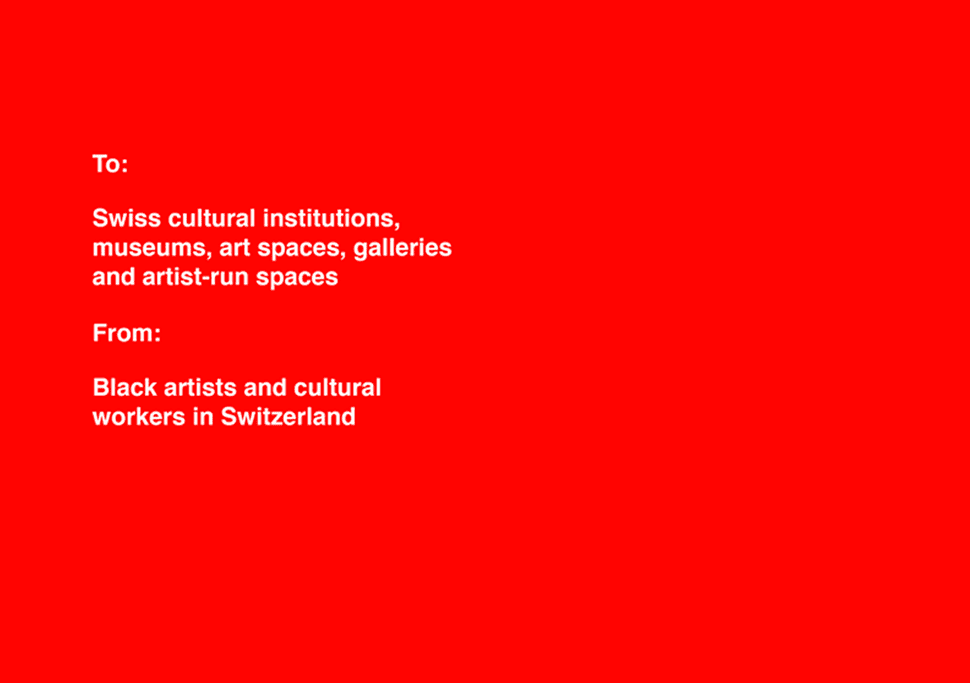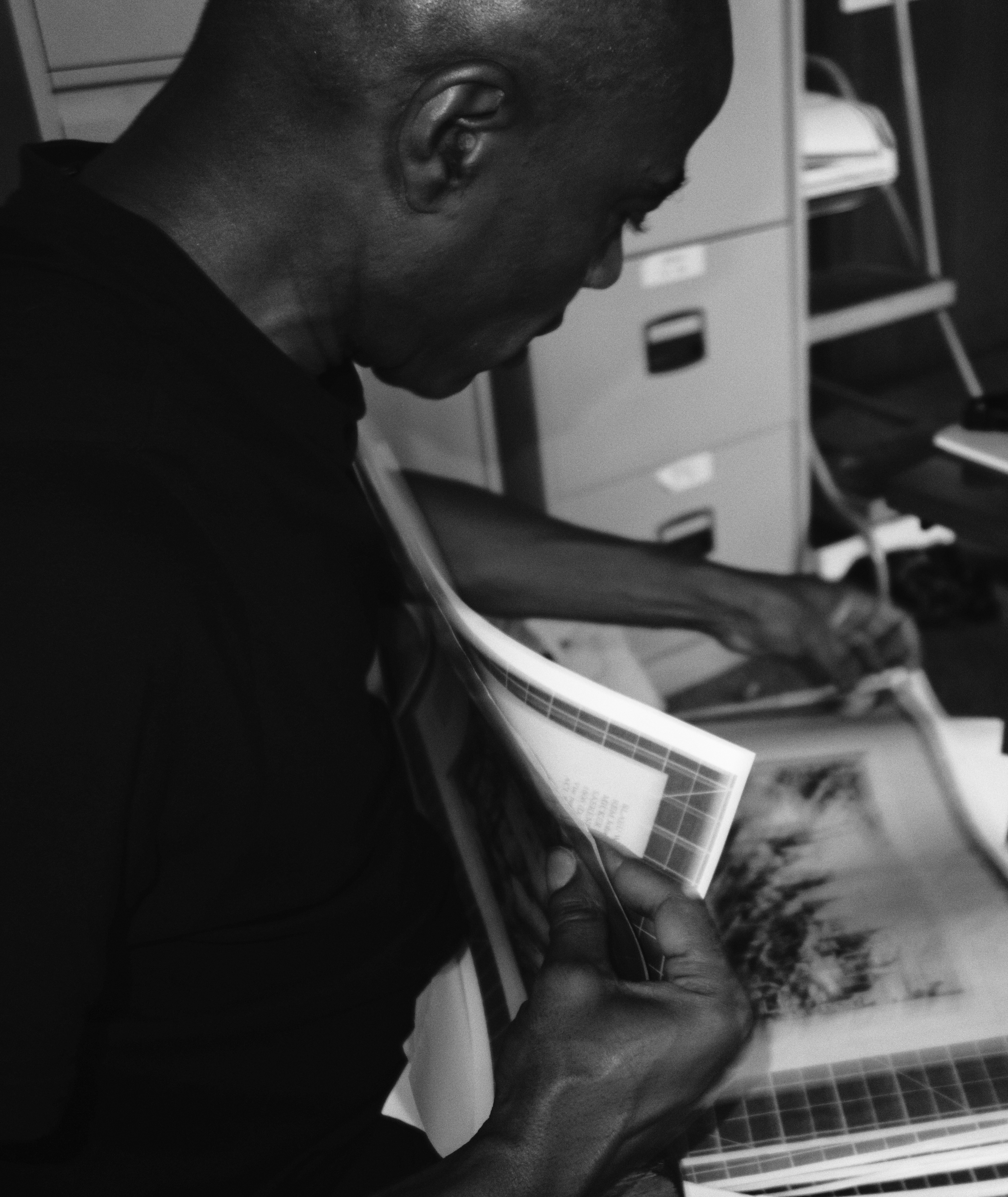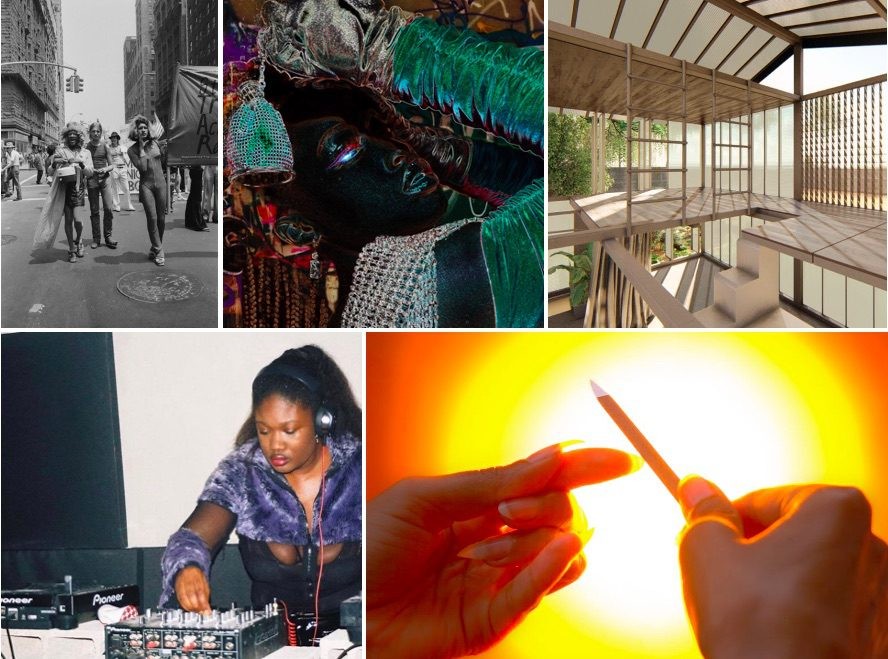On Anti-Blackness: An Open Letter to Swiss Institutions

17 July 2020
Magazine C& Magazine
12 min read
Amid the Black Lives Matters protests after the killing of George Floyd, several art and cultural institutions in Switzerland showed their support by posting a black square on social media. Taking this chance to instigate structural change in the system, a group of Black artists and cultural workers in Switzerland wrote an open letter addressed …
Amid the Black Lives Matters protests after the killing of George Floyd, several art and cultural institutions in Switzerland showed their support by posting a black square on social media. Taking this chance to instigate structural change in the system, a group of Black artists and cultural workers in Switzerland wrote an open letter addressed to these institutions. The letter includes a set of questions regarding their working practices and collections in relation to Black people. We spoke to Deborah Joyce Holman and Jasmine Gregory, two of the group’s artists, about their intentions and the response to the letter so far. You can read the full letter by following the link below.
READ THE FULL OPEN LETTER HERE
“Whether it be the police force or the art museum, there is seemingly no limit to the lengths and depths to which racism will go to perpetuate itself. It should therefore come hardly as a surprise that we are particularly frustrated and dismayed by seeing some of these same institutions now claiming anti-racist stances on social media.” –Black Artists and Cultural Workers in Switzerland
C&: Why did these last protests spark this letter? What hit differently this time round?
Deborah Joyce Holman: Before I say anything, I’d like to clarify that I am not answering in any shape or form in the name of all signatories of the open letter – rather these are all my views as an individual. Following George Floyd’s brutal murder we have observed a wave of protests and solidarity across the world. Many Swiss art spaces have also taken to social media to state their solidarity, which never happened in response to any of the multiple cases of excessive police brutality in Switzerland, and does not extend to people who have been murdered by police in Switzerland. Now people across Europe are saying they’ve had enough: while standing in solidarity with the US, we want institutions and representatives of our own countries to acknowledge, address, and deal with the massive problem that racism and white supremacy poses for us right here in Europe, too. The raised awareness at the moment served as an entry point to demand these institutions’ and art spaces’ accountability.
Jasmine Gregory: As a US American, I felt responsible to respond to the current events occurring in my country. I think in general the whole world is in a crucial period of change. Since I am Swiss-based, I thought it would be important to focus on my current environment. After seeing a lot of institutions showing support or interest in the BLM movement through social media, I thought that it was imperative to create a unified response with other Black artists in Switzerland to ensure that those institutions’ support or interest does not become solely a performative act.
C&: You’ve mentioned cases in which people have received threats for speaking out. Are there also cases people are being rewarded?
DJH: There definitely are cases where artists are highlighted for their activist work. This is both encouraging and frustrating, because frequently there is no consideration for the fact that these people often do this work not out of a particular interest in it, but out of a simple urgent need to first create the context and conditions to show their work in before being able to show it. The fact that often global majority voices get spotlighted when we speak of our experiences of racism while our artistic or cultural work does not get nurtured in the same way speaks to a larger problem of tokenization, pigeon-holing, and turning Black trauma into something consumable. The flip side to this is the gaslighting and threats that are often reactions to our speaking out. I personally have had such experiences, most notably with the Museum of Modern and Contemporary Arts in Geneva (MAMCO).
JG: I have only lived in Switzerland for two years. Swiss culture is extremely difficult to understand for many foreigners, including myself. I am still trying to figure out where I stand in terms of speaking out, etcetera. I also want to give space to those who are Swiss natives and identify as BIPOC. I have encountered a few situations where BIPOC people have been excluded in conversations regarding post-colonialism. This is ridiculous and I found it necessary to speak out. In terms of careers flourishing, I think that white people tend to fetishize Black trauma instead of looking inward towards their own trauma as it has to do with whiteness and white supremacy. This doesn’t really solve any problems at all. It’s all surface-level. We will never be able to fix anything until we look inwards.
C&: Switzerland is not perceived as having the same brutal colonial history as its western European neighbors. Nonetheless, anti-Black racism is glaring in the country across the board, and often unchallenged. Why is that?
JG: Switzerland has a stereotype of being neutral throughout history. This is absolutely not true, as this country was very complicit and benefited from colonialism and World War II.
DJH: A large part of Switzerland’s national identity builds on the idea of its political neutrality. This myth extends to a strong faith in the neutrality of press, media, and internal politics. I am convinced that this is a large contributing factor for why many people in Switzerland find it so difficult to believe how insidious and pervasive racism really is here. This in itself obviously perpetuates racism further. Swiss colonial history has not been addressed extensively publicly, nor is its role in the transatlantic slave trade taught in schools. That blind spot creates an always a handy excuse, supporting the lie that structural racism in Switzerland doesn’t exist.
C&: What has been the response to the letter so far and what could be the next step in response to it?
DJH: Responses have been mixed. Many of the addressees have asked to have further conversations, some have responded very poorly – and almost none have engaged with the questions we provided in a tangible and public way. We received several invitations to have informal conversations, which I will interpret as invitations to provide more free labor – an issue that was raised in the letter itself.
JG: For me, it is more important that these institutions self-reflect on their practices if they truly care about being non-racist. In a bigger sense, every problem in the world is interconnected, so having an introspective outlook is extremely crucial regardless. Western art institutions were built on white supremacy. They were linked to the colonialist desire to internationally collect and hoard objects and cultural artifacts and ideas, which were left for the interpretation by a select few from the Western world. This resulted in major destruction on non-Western bodies and environments. I think we have to figure out how institutions can better serve the community around them, artists etcetera, instead of serving the elite.
C&: Are there any institutional anti-racist examples in Switzerland you would like to see all other art institutions in the country follow?
DJH: I know a few curators and directors who are dedicated to working through structural bias at least as far as their program goes, such as, for example, HeK Basel and La Becque residency. This is always great and heartening to experience. I believe the process of facing the structural problems in each institution will look different as the staff that constitutes each place will have different knowledge. It is crucial to understand that while these are structural problems, each and every one of us working within these structures have internalized their biased set of values and it is the first, basic step to confront ourselves with that. Structural problems need to be addressed from the micro (individuals working in the institution) to macro (public programming) scale and everything in between. It takes a never-ending commitment.
JG: Since I am relatively new here, I am still learning and observing. All I can say is, it is imperative to think about how we can also get rid of classism, elitism, and all forms of exclusion, in order to obliterate racist practices. This might seem obvious but I think a lot of people like to divide various measures of exclusion without understanding how they are interconnected. I see various institutions in the US that are technically racially diverse, yet still act in ways that are classist and do not reflect the community around them. This, again, is highly problematic. Combatting these structural issues requires a lot more than inclusion and diversity. The whole ideology of what an institution is needs to change. To my knowledge, Switzerland prides itself on elitism and exclusion. Confronting these ideologies might be challenging to some.
C&: Why is it important to distinguish anti-Black discrimination in the Swiss cultural scene?
DJH: We’re now experiencing a widespread discussion around racism in Switzerland. Often these conversations fail to understand the specificities of different forms of oppression, for example: xenophobia and racism are spoken about as if they were the same. We’re also observing how the conversation around anti-Black racism gets convoluted with all forms of racism and how Black voices and struggles specific to anti-Blackness get erased from that conversation. It is therefore important that we are able to speak about this specific problem. However, at the end of the day, we are fighting for the end of white supremacy – which is to say, we’re fighting for the equity of all people of color.
JG: There are people here and abroad who refuse to think that Black people in Switzerland exist. It’s a bit nuts to me. Having someone who is not Black talk about discrimination in a Swiss context allows people not to face the realities Black people live in this country. Facing reality can sometimes mean facing conflicts. Not to paint everyone with the same brush, but the Swiss do not like conflicts.
C&: What needs to be done to address the questions posed in the letter?
DJH: The first step for this is the acknowledgement that each art space and each person is complicit in white supremacist structures, and that neither defensiveness nor silence are productive ways to address this fact.
C&: Many Black artists have shown support. How do you think artists can make a difference in a significant manner moving forward, in the long run?
DJH: We need to organize. As we’ve seen with this letter, there’s strength in numbers. Even if responses from the addressed art spaces have been underwhelming, it has created space for many urgent conversations and network-building. We need to stay persistent to have these conversations and hold our non-Black peers accountable in their choices to either perpetuate or dismantle racism, and specifically anti-Blackness. It is important to note that white supremacy is a white problem and white people desperately need to actively dismantle the ways in which white supremacy oppresses a global majority. I think there is something to say for the power that we, Black people and people of color, have even in refusal, and the realization that we have the right to ask for the cake and not just the crumbs, to ensure humane and equitable conditions for our work.
JG: This is an overwhelming question for me as I face various issues to stay in this country. Since I am on borrowed time here, it’s hard to think that much into the future and everything takes time. It’s best to come together as a community and to really try to figure out how we can heal, support ourselves, and network. We need to figure out our own systems and figure out how we can fund them as well.
Jasmine Gregory is a visual artist who lives and works in Zürich. She holds a MFA from ZHdK and BFA from the School of Visual Arts New York City. Her artistic practice focuses mostly on figurative painting; she references various visual styles including Dutch Vanitas, European Renaissance, cartoon references, childhood drawings, online virtual landscapes, and kitsch visual culture. Her paintings are meditations on the complexities of our society and what it means to be human as well as her role as a Black female painter. Her group exhibitions include Kunsthalle Zürich, Les Urbaines 2019, and Not Cancelled Salon.
Deborah Joyce Holman is an artist and curator based between London and Basel. Her work explores uses of language through various materials. Fluidity is an important element of her artistic and curatorial practice; some recurring themes in her work are the constant negotiation within notions of authorship, the limits of representation, and blurring between fiction, truths and facts. Her artwork has recently been shown at Material Art Fair, Mexico City; Fondation Entreprise Ricard, Paris; Mikro, Zurich; Auto Italia, London; and Alienze, Lausanne, among others. She is the founder and co-director of 1.1, a platform for emerging practices in arts and music with an exhibition space in Basel. She has curated two group exhibitions for the Lausanne multidisciplinary festival Les Urbaines, Lausanne, as well as the 2019 edition of BBZ BLK BK: Alternative Graduate Show, London. She currently works at Auto Italia, London, as associate director.
Interview by Will Furtado.
Read more from

On Ghosts and The Moving Image: Edward George’s Black Atlas

Confronting the Absence of Latin America in Conversations on African Diasporic Art

On Exile, Amulets and Circadian Rhythms: Practising Data Healing across Timezones
Read more from

C&’s Highlights of 2021 You Might Have Missed

